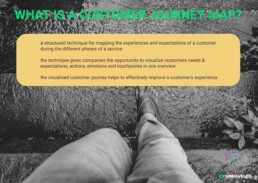Customer Journey Maps: Hype or Hope?
Over the past months quite some companies have approached us with the request to help them create customer journey maps. Which got us thinking - is this a hype which will blow over? Or is it the start of a hopeful process towards creating better customer experiences? I definitely think it should be the latter – HOPE. However, in order for customer journey maps to lead to better customer experiences, there are some important conditions which need to be met.
Before we dive deeper into these conditions, I’d first like to briefly share with you what a customer journey map is.

To elaborate more on this, a customer journey map literally visualizes the steps a customer takes when they interact with a specific service (or product for that matter) offered by a company. By understanding which steps a customer takes and examining their emotions during these steps, we’re given pretty important clues about which aspects of the customer journey need improvement. You’ve got it – one of the first things is to examine the steps where customers experience a negative emotion and see if you can improve those.
Now, back to the important conditions which need to be met in order for customer journey maps to actually lead to better customer experiences:
- Always base your customer journey maps on data verified persona’s. If your company has 6 different persona’s for instance, you need to create a journey map for each of these as your the needs, emotions and actions of these persona’s could differ greatly. Imagine the difference between the customer journey’s of a mom with children and a senior citizen in a supermarket. We know of a Dutch bank who actually has 300 different customer journeys – a mix of persona’s and the different products & services they offer.
- If you choose not to map a customer journey together with your customers (which might not be a bad choice if you have a lot of internal uncertainty which needs to be solved first), see if there is prior research & data available on which you can base your work. After that, do make sure that you validate the customer journey you created with actual customers who fit your persona. You might be surprised how many assumptions or hypotheses you have which don’t hold true when actually validating with customers.
- Once you’ve created and validated your customer journey map – SURPRISE – you’re not done. A customer journey map is not an end product, but a living document. If you want to ensure you deliver a consistent & great customer experience, you need to put into place measurements which help you monitor whether you are achieving the desired experience. Once those measurements dive under your target, it’s time to take a deeper look at that specific step in the customer journey and see how you can improve it. Make sure your management is also aware of this and support your continuous efforts to improve the customer experience.
If you take these conditions into account when mapping your customer’s journeys, you’re starting with a solid basis to actually create great customer experiences. Go for it! And if you need any help, don’t hesitate to reach out to us.
CitizenM - Blown away by the passion for their guests
Last week, I had the pleasure of meeting with Evelien van Damme and Diego Sartori. Both work in the CitizenM Support Office. Don’t be fooled, this is what most companies call their Head Office, but at CitizenM everyone serves the Ambassadors (=front line staff) who work in the hotels. Any people not directly working in their hotels work at the Support Office. And do you know what? Their CEO is actually at the bottom of this support pyramid. Revolutionary, but on the other hand so right!
For those of you who don’t know CitizenM – they are a hospitality company born out of the frustrations business travelers and weekenders experienced in more traditional hotels. You can find their mission statement below.

I was blown away by the passion both Evelien and Diego exhibit for CitizenM guests; something I honestly have never experienced before at other companies. While talking with them, they explained to me the CitizenM DNA, which comes down to their 5 core values:
- Passionate attitude
- Smart thinking
- Contemporary style
- Genuine touch
- Real Caring
At CitizenM all employees live & breathe these values. It starts during the hiring process, which they call Casting Days and has similarities with the X Factor show. CitizenM doesn’t hire people (necessarily) with a hospitality background, they hire for personality. And they use a bunch of very cool recruitment techniques to figure out someone’s personality.
- Who is Your Hero? Asking potentials to share their hero stories helps them figure out whether people are able to open up and share emotions.
- Blind Tasting. Tasting something without knowing what it is and then describing it to peers (without telling what you think it is), lets them see how people communicate
- They have potentials create a moodboard explaining what CitizenM is and isn’t, to figure out if they understand the concept and company values.
After recruitment everyone is trained in these values, they even get to experience them firsthand during their Experience Shift and Experience Stay. An Experience Shift is literally being an Ambassador for a day and shaking cocktails, preparing breakfast and doing basically anything required to give the CitizenM guests a blast of a time. The Experience Stay is when employees themselves are guests in a CitizenM hotel, so they too can experience the various parts of the customer journey and really feel what it is like to be a guest at CitizenM.
It doesn’t stop there – employees call each other out when they notice that they aren’t living up to the CitizenM values and Diego shared, that just last month during a Team Day 2 colleagues prepared a workshop to discuss which values they were living up to and on which values they needed to work.
We talked about lots more, but I wanted to share these particular items with you, because to me this makes CitizenM an outstanding CX Leader in the area of Customer Obsessed Culture. We’ll be back in a next blog to share the Factors of Influence you have as a company to create a Customer Obsessed Culture.
CX must-reads!
CX must-reads!
It’s good to see you reading my blog! It means that you would like to further deepen your knowledge about Customer Experience (CX) and I promise you it will be a lot of fun. Quite some people have asked me for book recommendations with more information & inspiration on CX. That’s why I’ve created this list of my Top 5 favorite CX books.
- Outside In by Harley Manning and Kerry Bodine. A golden oldie (published in 2012). But this Forrester Research duo has managed to explain the six disciplines of CX in a very digestible way: strategy, customer insights, human centered design, CX metrics, customer centric organization and a customer obsessed culture. Plus it’s full of inspiring real-life examples.
- De 9+ organisatie. Van marketshare naar mindshare by Berry Veldhoen & Stephan van Slooten. This one is for Dutchies only (sorry!), that is – until Berry & Stephan publish an English version. Berry & Stephen were pioneers in the CX field in The Netherlands and work together at Customer & Employee Experience Consultancy firm Altuition. They have combined their CX experiences in this book, which describes what companies should do if they want to create a great customer experience: (1) figure out what’s relevant from the customer’s perspective, (2) create & do new things which make the difference in the emotions and experience of the customer and (3) organize these new things systematically as part of their total service & proposition package.
- The Experience Economy by Joseph Pine II and James H. Gilmore. Another golden oldie (their original article was published in 1998), but if you order the 2020 edition you’ll find a brand new foreword with recent practical examples. This book explains how we’ve moved from commodities to goods to services to experience. It also gives plenty of inspiration on how you can create brilliant experiences in your own context.
- The Effortless Experience by Matthew Dixon, Nick Toman en Rick Delisi. A refreshing book in this top 5, because these gentlemen are definitely not about creating “WOW-moments” of so-called “customer delight”. Simply solve your customers problems in a quick & easy way! There’s definitely some sense in that (as their research shows) – especially for company departments such as customer service.
- Last but not least, The Power of Moments written by brothers Chip & Dan Heath. In this book the mystery of experience is slowly unravelled – why, for example do we remember the best and worst moments of an experience and forget the rest? A psychological take on customer experience, supported by great practical examples.
I’m super curious of your opinion on these books and would love to hear if you think other CX books should be added to this list. Have fun reading!


